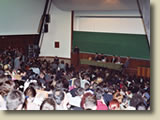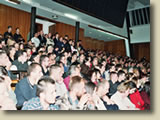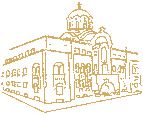|
|
Information
Service of
the Serbian Orthodox Church
September 29, 2004

THE
CHURCH AND THE MEDIA IN THE NEW MILLENNIUM
 On
Tuesday, September 28, 2004, a conference took place in the great
amphitheater of the Faculty of Machine Engineering of the University
of Belgrade on the topic of “The Church and the Media in the New
Millennium”. The event was organized by “Pravoslavlje” (Orthodoxy)
on the occasion of the 900th issue of this official publication
of the Serbian Patriarchate. On
Tuesday, September 28, 2004, a conference took place in the great
amphitheater of the Faculty of Machine Engineering of the University
of Belgrade on the topic of “The Church and the Media in the New
Millennium”. The event was organized by “Pravoslavlje” (Orthodoxy)
on the occasion of the 900th issue of this official publication
of the Serbian Patriarchate.
At the beginning of the conference, Professor Milos Kuburovic
welcomed all participants in the conference and the public, present
in great number, in front of the Faculty on behalf of Dean Nedeljkovic.
Sanja Lubardic then spoke on behalf of the “Pravoslavlje” editors,
emphasizing that the publication was celebrating its 900th issue
and reading a telegram of congratulation from His Holiness Serbian
Patriarch Pavle. Ms. Lubardic then introduced the speakers, who
needed no introduction: His Eminence Metropolitan Amfilohije of
Montenegro and the Littoral, His Grace Bishop Irinej of Backa,
His Grace Bishop Porfirije of Jegar, Protonamesnik Miodrag Popovic,
the editor-in-chief of “Pravoslavlje” and, lastly, Branimir Nesic,
the operations editor of “Pravoslavlje”.
 Protonamesnik
Miodrag Popovic reminded everyone that “Pravoslavlje” was launched
upon the initiative of a group of Belgrade intellectuals and His
Grace Bishop Lavrentije in 1967 as the magazine of the Archdiocese
of Belgrade and Karlovci, and that only after seven issues did
it become the magazine of the Serbian Patriarchate. The basic
theme of the periodical was the familiarization of the faithful
with the truths of Orthodox faith, and current events throughout
the Serbian Church. “Pravoslavlje” endured great problems during
the Communist period; on two occasions it was banned due to unsigned
texts by the Holy Bishop Nikola and Protopresbyter Dusan Ivancevic.
Protonamesnik Popovic reflected on these difficult times, and
especially on the first visit of His All-Holiness Ecumenical Patriarch
Athenagoras of Constantinople to Serbia. The issue of “Pravoslavlje”
devoted to the visit of this high church dignitary was 44 pages
long and sold approximately 30,000 copies. In closing, Protonamesnik
Popovic emphasized that the “Pravoslavlje” staff would continue
to follow religious and social events in the world and in Serbia,
that it would influence its faithful to avoid ethnology in the
description of church holidays, and that it would strive to provide
quality information for its readers regarding art history, architecture
and culture. Protonamesnik
Miodrag Popovic reminded everyone that “Pravoslavlje” was launched
upon the initiative of a group of Belgrade intellectuals and His
Grace Bishop Lavrentije in 1967 as the magazine of the Archdiocese
of Belgrade and Karlovci, and that only after seven issues did
it become the magazine of the Serbian Patriarchate. The basic
theme of the periodical was the familiarization of the faithful
with the truths of Orthodox faith, and current events throughout
the Serbian Church. “Pravoslavlje” endured great problems during
the Communist period; on two occasions it was banned due to unsigned
texts by the Holy Bishop Nikola and Protopresbyter Dusan Ivancevic.
Protonamesnik Popovic reflected on these difficult times, and
especially on the first visit of His All-Holiness Ecumenical Patriarch
Athenagoras of Constantinople to Serbia. The issue of “Pravoslavlje”
devoted to the visit of this high church dignitary was 44 pages
long and sold approximately 30,000 copies. In closing, Protonamesnik
Popovic emphasized that the “Pravoslavlje” staff would continue
to follow religious and social events in the world and in Serbia,
that it would influence its faithful to avoid ethnology in the
description of church holidays, and that it would strive to provide
quality information for its readers regarding art history, architecture
and culture.
Branimir
Nesic presented the 900th issue and the following new columns:
the Church and youth, Christian periodicals, the crucified metoh
(church estate) and the Kosovo Covenant, the emigrant community,
the living letter, and album images (launched by Antonije Djuric).
 His
Grace Bishop Porfirije of Jegar spoke regarding the general role
of the media in the Church, and the Church in society through
the media. It is a great joy that young people are entering the
Church where they have the opportunity to enhance their potential.
Today there are many who view the activity of the Church in an
ideological and political context, citing the legacy of the French
Revolution. Religion, in their opinion, is a private matter. This
form of secularism, which literally banishes God, is leading humanity
to self-destruction. The Church should strive to desecularize
society through the media. Bishop Porfirije emphasized that in
1929 the radio program in this region contained ample religious
content whereas today the situation is catastrophic. He compared
this with the media of neighboring countries, citing the example
of Croatian Radio Television, which broadcasts religious services
every Sunday, provides 25 minutes weekly of news from all Churches,
includes a seven minute-long interpretation of the Holy Gospel
every Saturday evening, etc. Bishop Porfirije concluded that we
must not simply give in to those who are fighting against spirituality;
instead, we must spread the good news of Christ everywhere because
by doing so we will not be denigrating but affirming evangelical
values. He also presented the idea of organizing the media under
the auspices of the Serbian Orthodox Church. His
Grace Bishop Porfirije of Jegar spoke regarding the general role
of the media in the Church, and the Church in society through
the media. It is a great joy that young people are entering the
Church where they have the opportunity to enhance their potential.
Today there are many who view the activity of the Church in an
ideological and political context, citing the legacy of the French
Revolution. Religion, in their opinion, is a private matter. This
form of secularism, which literally banishes God, is leading humanity
to self-destruction. The Church should strive to desecularize
society through the media. Bishop Porfirije emphasized that in
1929 the radio program in this region contained ample religious
content whereas today the situation is catastrophic. He compared
this with the media of neighboring countries, citing the example
of Croatian Radio Television, which broadcasts religious services
every Sunday, provides 25 minutes weekly of news from all Churches,
includes a seven minute-long interpretation of the Holy Gospel
every Saturday evening, etc. Bishop Porfirije concluded that we
must not simply give in to those who are fighting against spirituality;
instead, we must spread the good news of Christ everywhere because
by doing so we will not be denigrating but affirming evangelical
values. He also presented the idea of organizing the media under
the auspices of the Serbian Orthodox Church.
At
the beginning of his presentation, His Grace Bishop Irinej of
Backa recalled working in Television at the beginning of the 1990s
in the capacity of editor of Bukvar Pravoslavlja (Primer of Orthodoxy).
This was a shortened catechesis in television form prepared through
the joint efforts of Metropolitan Amfilohije and Bishops Porfirije
and Irinej. As well, Bishop Irinej was a participant in the first
post-war discussion between two members of the clergy directly
broadcast by television. This was the first instance where the
clergy could speak live since World War II. After this introduction,
Bishop Irinej emphasized that today relations with the media are
catastrophic because of supposed experts on behind the scenes
activities in the Church. He also expressed some self-criticism
with respect to the official publication of the Serbian Orthodox
Church, noting that there have been instances of factual errors
published because the editors were primarily tasked with other
responsibilities within the Church. Today there is a tendency
toward falsely describing church life, and that is why all media
should ask senior church dignitaries whether they agree with the
texts that are being published. As a negative example, Bishop
Irinej cited the church celebration of the Bicentennial of the
First Serbian Uprising, which television stations refused to broadcast
live even though they were asked to do so. Instead, news of this
grand event, which was attended by His All-Holiness Ecumenical
Patriarch Bartholomew of Constantinople, lasted all of twenty
seconds on the evening news, and was broadcast just before sports.
His
Eminence Metropolitan Amfilohije of Montenegro and the Littoral
emphasized that at the time the first issue of “Pravoslavlje”
was published, the Church was called the Church of Silence. In
an age of much ado and a deluge of wasted words, “Pravoslavlje”
has been trying in 900 issues to shape the Word – Logos. “Pravoslavlje”
strives to make the Word strong and powerful, and to make it divinely
inspired.
In
conclusion, despite criticism Bishop Irinej emphasized that there
are local television stations that are trying to organize their
programs according to Christian principles. As a very positive
example, he cited Television Trstenik – LOGOS.

SERBIAN
PATRIARCH MEETS WITH DELEGATION
OF COMMUNITY OF WESTERN RITE ORTHODOX IN FRANCE
Upon
the invitation of His Holiness Serbian Patriarch Pavle, on September
29, 2004 in the Belgrade Patriarchate, a meeting was held between
the Serbian Patriarch and a delegation of the community of Western
Rite Orthodox in France. His Holiness Patriarch Pavle together
with His Eminence Metropolitan Amfilohije of Montenegro and the
Littoral, and His Grace Bishop Luka of Western Europe received
the delegation. The delegation of the community of Western Rite
Orthodox in France included Protopresbyter Jean Pierre Paud, Protopresbyter
Maxime Jordan, Protopresbyter Pierre Francois Meant, and Mr. Guy
Treca. (All name spellings are approximate.) Presbyter Jovan Georgievski,
the parish priest in Paris, and Mr. Kosta Hristic, the vice-president
of the Executive Council of the Diocese of Western Europe also
attended the talks.
At
the beginning of the conversation the delegation expressed their
desire to be under the jurisdiction of the Serbian Orthodox Church
within the framework of the Diocese of Western Europe, and by
uniting with the Orthodox Church to preserve their liturgical
tradition.
His
Holiness listened to the presentations of the dear guests with
great interest and demonstrated understanding for the difficult
situation of this community, which currently numbers approximately
ten parishes with more than a thousand faithful.
After
a thorough discussion a decision was reached to form a special
committee of the Holy Assembly of Bishops of the Serbian Orthodox
Church to look into the matter and prepare a proposals for the
next session of the Holy Assembly of Bishops.

BAPTISM
OF SERBIA AND MONTENEGRO ARMY MEMBERS AT VAVEDENJE MONASTERY NEAR
CACAK
On
Tuesday, September 28, 2004, the first collective baptism of officers
and soldiers from one Serbia and Montenegro Army unit took place
in the monastery of Vavedenje (the Entry of the Most Holy Theotokos
into the Temple) located eight kilometers from Cacak. It was the
baptism of five members of the Rear Headquarters of the Serbia
and Montenegro Army General Staff, and the mother of one member.
The ceremony was attended by about one hundred uniformed members
of the unit who left the monastery with their newly baptized colleagues
for a luncheon prepared in the garrison of the Serbia and Montenegro
Army in Pozega. The sacrament of baptism was conducted by Father
Milorad Cicovic accompanied by the prayers of the nuns of this
female monastery. Also present was the commander of the Rear Headquarters
of the General Staff, Colonel Dragomir Krstovic, who said that
members of this unit visited 25 monasteries throughout Serbia
during the course of the past year for baptisms, and thus the
idea was born to baptize those who for various reasons were not
baptized immediately upon birth. Colonel Krstovic called on all
officers and soldiers in the unit to be baptized if it was in
accordance with their wishes and something they as individuals
wished. Baptized yesterday were Colonel Radomir Jovanovic, assistant
to the commander of the Rear Base for morale and information;
Captain First Class Sasa Petrovic of Belgrade and Dragomir Grujovic
of Cacak; a civilian employee of the Serbia and Montenegro Army,
Radmila Krsmanovic; and a contracted soldier from Lukovica near
Gornji Milanovac, Marijan Mirkovic, and his mother.
Source:
Ekspres Politika daily, Belgrade, September 29, 2004

[Serbian
Translation Services]

Copyright © 1999-2004 by
The Information Service of
the Serbian Orthodox Church
11000 Belgrade
Kralja Petra I no.5
+381 11 3282 596
e-mail
|

